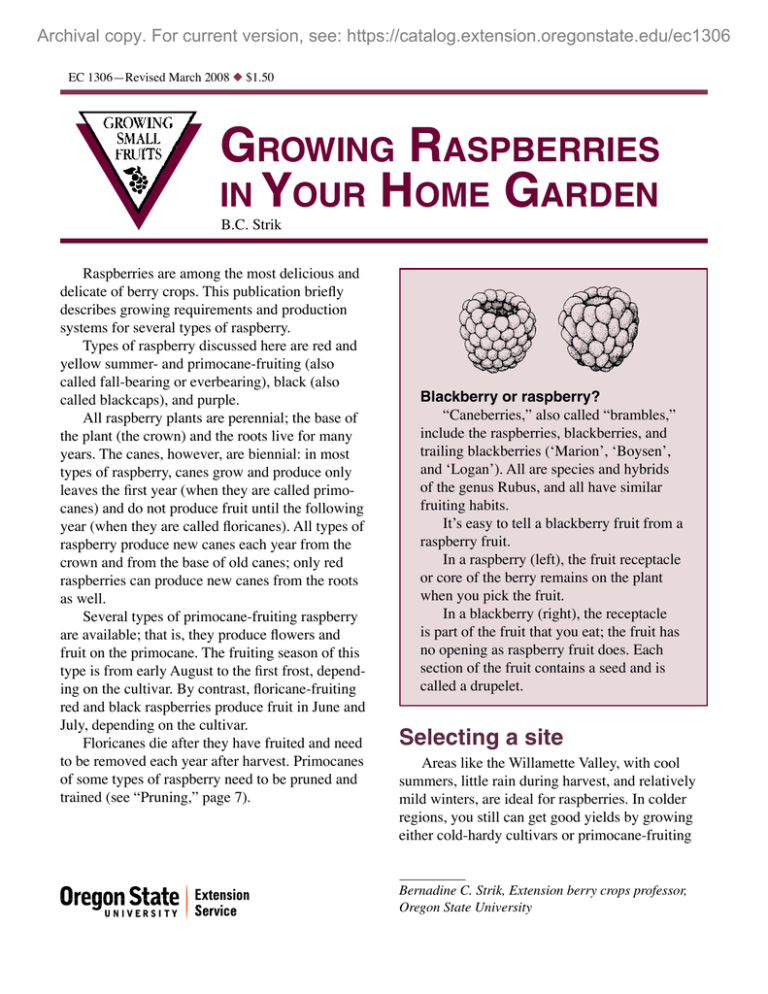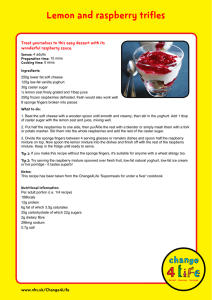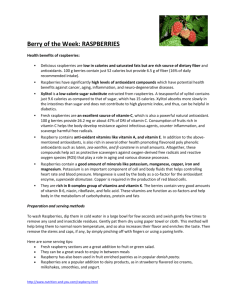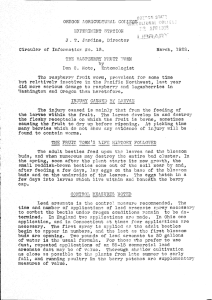G r Y
advertisement

Archival copy. For current version, see: https://catalog.extension.oregonstate.edu/ec1306 EC 1306—Revised March 2008 u $1.50 Growing Raspberries in Your Home Garden B.C. Strik Raspberries are among the most delicious and delicate of berry crops. This publication briefly describes growing requirements and production systems for several types of raspberry. Types of raspberry discussed here are red and yellow summer- and primocane-fruiting (also called fall-bearing or everbearing), black (also called blackcaps), and purple. All raspberry plants are perennial; the base of the plant (the crown) and the roots live for many years. The canes, however, are biennial: in most types of raspberry, canes grow and produce only leaves the first year (when they are called primocanes) and do not produce fruit until the following year (when they are called floricanes). All types of raspberry produce new canes each year from the crown and from the base of old canes; only red raspberries can produce new canes from the roots as well. Several types of primocane-fruiting raspberry are available; that is, they produce flowers and fruit on the primocane. The fruiting season of this type is from early August to the first frost, depending on the cultivar. By contrast, floricane-fruiting red and black raspberries produce fruit in June and July, depending on the cultivar. Floricanes die after they have fruited and need to be removed each year after harvest. Primocanes of some types of raspberry need to be pruned and trained (see “Pruning,” page 7). Blackberry or raspberry? “Caneberries,” also called “brambles,” include the raspberries, blackberries, and trailing blackberries (‘Marion’, ‘Boysen’, and ‘Logan’). All are species and hybrids of the genus Rubus, and all have similar fruiting habits. It’s easy to tell a blackberry fruit from a raspberry fruit. In a raspberry (left), the fruit receptacle or core of the berry remains on the plant when you pick the fruit. In a blackberry (right), the receptacle is part of the fruit that you eat; the fruit has no opening as raspberry fruit does. Each section of the fruit contains a seed and is called a drupelet. Selecting a site Areas like the Willamette Valley, with cool summers, little rain during harvest, and relatively mild winters, are ideal for raspberries. In colder regions, you still can get good yields by growing either cold-hardy cultivars or primocane-fruiting Bernadine C. Strik, Extension berry crops professor, Oregon State University Archival copy. For current version, see: https://catalog.extension.oregonstate.edu/ec1306 raspberries, pruned to produce only a late-summer crop. Roots of these cultivars will tolerate belowzero temperatures, but dry winter winds might damage canes. Raspberries produce best in full sun, but they can tolerate partial shade. Avoid a site where potatoes, tomatoes, peppers, eggplant, other caneberries, or strawberries have grown within the past 3 years. These crops are susceptible to many of the same insects and diseases as raspberries, so it’s important to rotate these crops from one site to another. Caneberry plantings are not rotated often because they live for a long time if grown on a good site. Expect your red raspberries to produce well in a good location for more than 15 years. Black raspberries have a shorter life span, 4 to 8 years. Drainage is the most important soil factor to consider when selecting a site. Raspberries are sensitive to wet soils, and most cultivars are susceptible to root rot, a soilborne disease that is aggravated in wet, heavy soil. In soils that are water-logged for more than a few days at a time, plants normally die a slow death from lack of oxygen or from subsequent attack by root diseases. Raspberry plants grow best in a well-drained, fertile, loam soil with moderate water-holding capacity. Avoid heavy clay soils. Sometimes you can improve a less desirable site by tiling, increasing organic matter content, and/or building raised beds (see “Preparing the soil,” page 3). Red raspberries will produce primocanes (called suckers) from the roots. These need to be managed to avoid having your planting spread or become weedy. Locate your raspberry patch so you can maintain the row by tilling on each side to control suckers. Selecting a cultivar Raspberry types differ in their cultural requirements, and cultivars differ in fruiting season, fruit quality, appearance, and flavor. It’s important to choose a cultivar adapted to your needs and site. For detailed information on cultivars within each type, refer to Raspberry Cultivars for Oregon, EC 1310. All raspberries are self-fruitful, so you need only one cultivar for pollination and fruit production. Red raspberry cultivars can be divided into two types: summer bearing, and fall- or everbearing. Summer-bearing cultivars are the most common; examples include ‘Willamette’, ‘Meeker’, and ‘Cascade Delight’. These produce fruit on the floricane, generally from about mid-June to mid-July. Primocane-fruiting raspberries, sometimes called fall-bearing or everbearing, produce fruit on the top portion of the primocane; examples include ‘Heritage’ and ‘Caroline’. The tip portion of the primocane dies after fruiting (Figure 1). If you leave these canes for next year, they’ll bear fruit on the portions that did not fruit the previous fall. Therefore, this type can produce fruit in both June–July (on the lower floricanes) and from August to frost (at the top of the primocanes). The early summer crop, however, is lower in yield and quality than the summer-bearing cultivars available. Yellow-fruited primocane-fruiting types are available. These are mutants of red raspberry and, except for fruit color, have all the characteristics of red raspberry; examples include ‘Fallgold’ and ‘Anne’. Oregon is the leading state in commercial production of black raspberries (blackcaps), Raspberry canes The two names for a raspberry cane describe whether the cane is in its first or second year of growth: Primocane—First year of growth; usually produces no fruit (although primocane-fruiting types do produce fruit on this cane). Floricane—Second year of growth; these produce fruit on branches called fruiting laterals. All kinds of raspberry produce fruit on the floricane. This cane dies after fruiting. 2 Archival copy. For current version, see: https://catalog.extension.oregonstate.edu/ec1306 Establishing your planting Preparing the soil You should be able to keep your raspberry planting productive for many years, so choose and prepare a good site before you establish the planting. In the year before you plant, eliminate all perennial weeds. Prevent weeds from going to seed! Raspberries grow best on well-drained soil that has a pH between 5.5 and 6.5. It’s best to check soil pH 6 months to a year before you plant. If the soil is too acidic (pH below 5.5), add lime to the soil as recommended by the soil test analysis. (For more information about soil testing, see Laboratories Serving Oregon: Soil, Water, Plant Tissue, and Feed Analysis, EM 8677, and Soil Sampling for Home Gardens and Small Acreages, EC 628.) A good supply of organic matter in the soil improves aeration and drainage and increases water-holding capacity. Apply organic matter the summer or fall before you plant; manure applied at 2 to 3 cubic yards per 100 square feet is a good source. You also can use decomposed (rotted) compost, leaves, or sawdust. Use only materials that you believe are free from insects and weed seeds. Dig, plow, or till the material into the soil to ensure that it will be well decomposed by planting time. If you incorporate large amounts of nondecomposed material into the soil, add calcium nitrate (16 percent nitrogen) at 2 pounds of product per 100 square feet to aid in decomposition. If you also use manure to improve soil structure, decrease the rate of fertilizer by half. If your garden is slow to drain or if the water table is high, you have to improve the situation, either by installing a drain tile at least 25 inches deep near the row or by planting in raised beds. It’s best to grow raspberries on a raised bed that is 1.5 to 2 feet high and about 2 feet wide. Raised beds can be constructed with wood walls, but Figure 1. A primocane-fruiting raspberry in winter, before pruning. Dead fruiting laterals are visible at tip of cane where fruit was harvested last fall. Unopened buds at base of cane may fruit next summer” which have a distinctive flavor; examples include ‘Munger’ and ‘Jewel’. Blackcaps produce fruit on floricane branches. This type of raspberry requires summer pruning. Purple raspberries are hybrids of red and black raspberries; examples include ‘Royalty’ and ‘Brandywine’. Their growth habit is most similar to that of blackcaps. The fruit is considered best when processed into pies or jellies. Whichever type and cultivar you choose, buy only certified, disease-free plants from a reputable nursery. Even though it’s tempting, because it’s easy and free, don’t start your new planting with suckers (primocanes) dug up from your old patch or someone else’s; this will introduce potentially pest-infested soil and virus-infected plants to your new planting. 3 Archival copy. For current version, see: https://catalog.extension.oregonstate.edu/ec1306 walls are not necessary if you can form a raised bed by hilling natural soil with any organic matter incorporated in it. spread out the root mass and set the plant so that the highest point of attachment of roots to cane is 1 to 2 inches below ground level. Cover with soil and press firmly to remove air pockets. Water the plants well to settle the soil. Cut canes on newly set bare-root plants to 6 inches at planting time. Tissue cultured plants need more care early on and should be treated like a vegetable transplant, i.e., water frequently until the plants are established. No fruit will be produced in the planting year, except for a small crop on primocane-fruiting types. All raspberry plants might produce a “baby” crop the year after planting, and all will produce a mature crop in the third year. Planting systems The hedgerow and hill planting systems are most popular for the home garden. In the hedgerow system, space red raspberry plants 2 feet apart in rows about 8 feet apart. Allow new primocanes to spread along the row, but don’t let them spread farther than 12 inches to keep the raspberry row to the correct width. Wider rows are more difficult to weed and prune, and they promote the development of diseases that thrive in damp, slow-drying conditions. In the hill system, “hill” refers to the cluster of canes that develops around a single plant, not to planting atop a mound of soil. Space plants 21⁄2 feet apart within the row, and allow 8 feet between rows. Confine hills to a diameter of about 1 to 11⁄2 feet by removing all suckers that develop between hills or in aisles. Black and purple raspberries generally need more space than red raspberries. Set plants 3 to 4 feet apart in the row, and allow 8 to 10 feet between rows. Fertilizing In the planting year, fertilize each plant with a total of 0.5 to 1 ounce of nitrogen (N), depending on soil fertility; use a well-balanced fertilizer such as 16-16-16. To calculate how much product to apply during the year, divide the desired amount of N (in this case, 1 ounce) by the percentage of N in the fertilizer (16% = 0.16; 1 ÷ 0.16 = 6.3 ounces of product per plant). In new plantings, do not apply all of the fertilizer at once. Instead, divide the total amount (1 ounce of actual N) into thirds, and apply the first third 2 weeks after planting, the next third 1 month later, and the final third an additional month later. In the above example, you would apply 2.1 ounces of 16‑16‑16 per application per plant. Distribute the fertilizer evenly in a small area around the young plant. Planting It’s best to purchase certified disease-free raspberry plants from a nursery. Plants from a noncertified source could introduce root rot organisms or viruses into your garden. Traditionally, raspberry plants have been sold as fairly large bare-root plants; now, however, lush, tender, tissue-cultured plants in small cell packs are becoming more common. If you buy plants but can’t put them in immediately, “heel” them into moist soil or sawdust to prevent the roots from drying. Plant as early as you can work the soil in spring. Dig a shallow hole, large enough to accommodate the roots. If you have bare-root plants, Irrigating Irrigate to supply plants with about 1 inch of water per week, supplementing rainfall as needed. Keep the area around plants free of weeds. Drip or soaker hose irrigation is ideal because it does not wet the fruit and foliage, which would encourage disease problems. 4 Archival copy. For current version, see: https://catalog.extension.oregonstate.edu/ec1306 Trellising Summer-bearing red raspberries need support to hold the canes upright. Depending on row length, at each end of the row set wooden end posts (3 to 4 inches in diameter and 6 feet above ground) and metal posts every 15 to 20 feet in the row. Training is easier if you have two sturdy wires at the top of the trellis (nearly 6 feet high), one on each side of the post. Also place two wires at about knee height, so you can lift them out over new primocanes to pull them into the row and prevent breakage during the growing season (Figures 2–4). Use high-tensile wire and add a wire-tightener in each of the top wires. You can use a trellis with a cross arm. Nail or bolt a cross arm about 18 inches long near the top of each post (Figure 2). For primocane-fruiting raspberries, you can use a temporary support structure if plants are cropped only in the fall (see “Pruning,” page 7). A simple “T” trellis at about knee height with a top 11⁄2 feet wide will support the canes. This can be made using rebar with twine or wire strung down each side of the row (Figure 5, page 6). Black and purple raspberries do not need a trellis, although you may wish to use a simple trellis like that described for the primocane-fruiting types. 18" cross arm 41⁄2 to 5' 30" Figure 2. Four-wire trellis with cross arms. Cross arms for the top two wires spread out the fruiting canes and leave room for new primocanes to grow between the wires. A B B 41⁄2 to 5' 30" Figure 3. Three-wire trellis with wires fastened directly to posts. Single top wire is stapled to post. Two bottom wires are on hooks or bent nails so they can be lifted and swung out over primocanes to pull them in. Hills with up to six or seven canes are tied in a single bundle (A). Hills with more canes (B) can be split, with part going halfway to the next plant in the row. Figure 4. Summer-bearing red raspberry trained to a trellis, after pruning, in the hill system. 5 Archival copy. For current version, see: https://catalog.extension.oregonstate.edu/ec1306 7 to 8 feet high. Reduce the annual application of fertilizer if canes become too tall, are too small in diameter (less than 0.37 inch), or the internode length (distance between leaves on the cane) is long. Irrigating Established raspberry plants need 1 to 1 1 ⁄2 inches of water per week from mid-June through late summer. Irrigate when rain doesn’t provide this amount. Extremely warm and windy conditions increase water requirements. To avoid excessive disease in canes or fruit, it is best to use drip or under-canopy sprinklers. Figure 5. ‘Heritage’ showing temporary trellis to support new primocanes in hedgerow. Care of established plantings Checklist for establishing your planting and caring for it the first year Fertilizing After the planting year, apply fertilizer annually to maintain good growth and leaf color. Each year, apply a total of 2 to 3 ounces of N per 10 feet of row (12.5 to 18.7 ounces of 16-16-16 fertilizer). Apply one-third of the total when the new primocanes start to grow, one-third at the end of May, and one-third at the end of June. Broadcast the fertilizer: spread it over the surface of the soil in the row in a band about 2 feet wide centered on the row. Irrigate right after fertilizing. If you use manure, apply it in late fall or early winter. Reduce the rate of nitrogen fertilizer by one-half. Manure applied early in the fall might extend raspberry growth later into fall, which might make plants more susceptible to winter injury. A good guide for fertilization is to observe plant growth. Leaves should be a healthy green; pale green or yellow primocane leaves might indicate nitrogen deficiency. Also, primocanes of established red raspberry plants should reach • • • • • • • • • • 6 Choose a good site. Eliminate all perennial weeds before they go to seed. Choose cultivars suitable for your needs and site. Prepare the soil by applying organic matter and, if necessary, installing a drain tile and/or forming raised beds. Apply fertilizer and till the soil. Purchase certified disease-free plants. Plant in spring. Remove excess primocanes (suckers): — In the hedgerow system (red raspberry), keep the row confined to a width of 12 inches or less. — In the hill system (red and purple ­ raspberries), confine hills to 1 to 11⁄2 feet in diameter. Irrigate as required. Build a trellis (especially for summer-bearing red raspberry). Archival copy. For current version, see: https://catalog.extension.oregonstate.edu/ec1306 Weed management Cultivate to control weeds and primocanes that develop between hills and in the row aisles. Cultivate no deeper than 1 to 2 inches to prevent root damage. You can use a mulch or landscape cloth (weed mat) around blackcaps to control weeds. However, a weed mat is not recommended for red raspberries because it prevents primocanes from emerging from the roots. If you use organic mulches, you might need to apply additional nitrogen fertilizer to help break them down. While herbicides may be labeled for raspberries in the home garden, be aware that the commonly used herbicide glyphosate (e.g., Roundup) is not labeled for use on raspberries. Raspberries are very sensitive to glyphosate; if it drifts onto plants, you will see dramatic foliage symptoms and sometimes plant death. Figure 6. Typical three-wire trellis design for arc-trained red raspberries. The top wire usually is 41⁄2 to 6 feet above ground. Wire tensioners at the ends of rows and open hooks on the poles allow the lower wires to be pulled out to catch canes and bring them into the centers of the rows. Pruning Summer-bearing red raspberry. Don’t top primocanes during the growing season. Remove old, dead floricanes in late summer or fall. From January through early March, while plants are dormant, remove all weak, broken, diseased, and insect‑damaged canes. In the hill system, leave all the healthy primocanes in each hill. In the hedgerow system, narrow the row to 12 inches wide. Shorten the canes in both systems so they are about 6 feet tall, and tie them to the trellis (Figures 2–4). This type of system promotes large fruit. If, however, you are willing to sacrifice about half a gram in average fruit weight to a higher yield, train almost the entire cane length by tying the bundle of canes from a hill to the top wire and then looping it downward and tying the end (Figure 6). Primocane-fruiting raspberries. Grow primocane-fruiting raspberries in a hedgerow. If plants are grown for both early- and late-summer crops, remove old floricanes after harvesting the summer crop. The fall crop will be borne on the tips of primocanes that grew while the summer crop was ripening. When plants are dormant, remove weak or damaged canes and the tip portions of canes that fruited last fall (Figure 1). Figure 7. Black raspberry primocane after summer tipping. Narrow the hedgerow as for summer-bearing raspberries. To grow primocane-fruiting raspberries for a fall crop only (the best method in cold regions), cut all canes to ground level in late March. When the new primocanes emerge, maintain a row width of about 12 inches (Figure 5). Fruit will be produced on the tips of the primocanes in late summer. If you have enough space to grow two types of raspberries, grow a primocane-fruiter for only the primocane crop. If you want fruit in June–July, it’s best to grow a summer-bearing type, as these have better fruit quality and a higher yield than primocane-fruiting types. Black and purple raspberries. Remove the top 3 to 4 inches of primocanes during late spring or early summer. Top black raspberries (blackcaps) 7 Archival copy. For current version, see: https://catalog.extension.oregonstate.edu/ec1306 and purple raspberries to a height of about 3 feet. Go over the planting several times during the summer to catch all the primocanes, as they don’t all grow at the same rate. With topping, primocanes will produce lateral branches (Figure 7). When plants are dormant, remove all damaged canes. Shorten lateral branches of both types to about 11⁄2 to 21⁄2 feet. Cut unbranched canes to about 3 feet. After harvest, remove all dead floricanes. Harvest Pick fruit every 3 or 4 days. Regular picking helps avoid some disease and insect pests that like overripe and rotting fruit. When berries are ripe, they are quite easy to pull off the receptacle or plug (the portion that remains on the plant). Pick into a shallow container to prevent crushing the Pruning schedule for red raspberries Summer-bearing • Spring and summer: Remove all primocanes • • that grow between hills or in row aisles by pruning or cultivation. Summer or fall: Prune out the floricanes after you’ve picked all the fruit. Winter: Top the canes to 6 feet tall or train the entire cane in an arch. Primocane-fruiting • Summer and fall crop: Prune as for summer- • bearing; but rather than top at 6 feet, top canes in winter by removing the portion that fruited the previous fall. Late-summer or fall crop only: — Late winter: Cut all canes to ground level. — Spring and summer: Maintain row at about 12 inches wide. — Late summer and fall: Harvest fruit. © 2008 Oregon State University fruit. To extend shelf life, avoid picking when berries are wet, and refrigerate as soon as possible. Expect the following yields per 20 feet of row: 50 to 70 pounds for summer-bearing red raspberries, 30 to 40 pounds for primocane-fruiting raspberries, and 15 to 25 pounds for black r­ aspberries. Pests A number of insect and disease problems can affect raspberries, such as root weevils, leafroller larvae, spider mites, aphids, powdery mildew, anthracnose, Verticillium wilt, and phytophthora root rot. Cold injury can cause crop loss; blackcaps are the most sensitive to cold, but red raspberries also can be injured, depending on year and production region. Hot summers may sunburn fruit or cause ultraviolet (UV) light damage; symptoms include white drupelets. Check with your county office of the OSU Extension Service for recommendations on pest and disease control. Or, visit Extension’s online PNW pest management handbooks at http://pnwpest.org/ For more information Raspberry Cultivars for Oregon, C. Finn and B.C. Strik, EC 1310. Laboratories Serving Oregon: Soil, Water, Plant Tissue, and Feed Analysis, J. Hart, EM 8677. Soil Sampling for Home Gardens and Small Acreages, M. Rebotham and J. Hart, EC 628. Many OSU Extension Service publications may be viewed or downloaded from the Web. Visit the online Publications and Videos catalog at http:// eesc.oregonstate.edu/catalog Copies of our publications and videos also are available from OSU Extension and Experiment Station Communications. For prices and ordering information, visit our online catalog or contact us by fax (541-737-0817), e-mail (puborders@oregonstate.edu), or phone (541-737-2513). Trade‑name cultivars and products are listed as illustrations only. The OSU Extension Service does not endorse any listed cultivar or product or intend any discrimination against others not listed. This publication was produced and distributed in furtherance of the Acts of Congress of May 8 and June 30, 1914. Extension work is a cooperative program of Oregon State University, the U.S. Department of Agriculture, and Oregon counties. Oregon State University Extension Service offers educational programs, activities, and materials without discrimination based on age, color, disability, gender identity or expression, marital status, national origin, race, religion, sex, sexual orientation, or veteran’s status. Oregon State University Extension Service is an Equal Opportunity Employer. Publishedd July 1989. Revised March 2008.






